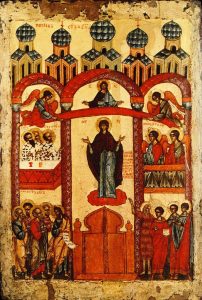Church of the Intercession of the Mother of God in Medvedkovo

The Church of the Intercession of the Most Holy Theotokos in Medvedkovo (Pokrovskaya Church, Bogoroditskaya Church) is a parish Orthodox church in the Yuzhnoye Medvedkovo district in the north of Moscow, in the former village of Medvedkovo. It belongs to the Sergievsky deanery of the Moscow Diocese of the Russian Orthodox Church. One of the last Moscow single-frame churches. The Church of the Intercession of the Blessed Virgin Mary in Medvedkovo was built in 1635 by Prince Dmitry Pozharsky in honor of the liberation of Russia from Polish intervention. The architectural structure is a smaller version of the Cathedral of the Intercession on the Moat and is one of the last Moscow single-frame churches; seventeen years after the completion of construction, Patriarch Nikon imposed a ban on the construction of temples of this type. Until 1635, the wooden tent church of the Intercession with the chapel of Peter of Alexandria, founded no later than 1623-1624, stood on the site of the stone building. According to sources, in 1635 the church had four chapels: the Signs of the Blessed Virgin Mary, Peter of Alexandria, Barlaam of Khutynsky and Anthony the Roman. The name of each chapel is associated with Veliky Novgorod, where Pozharsky served as voivode in 1628-1630: the icon of the Sign is the main shrine of this city and the entire Novgorod land, and Varlaam Khutynsky and Anthony the Roman are famous Novgorod ascetics. In 1652, on the tenth anniversary of the death of the famous voivode, his heir, Prince Ivan Dmitrievich Pozharsky, received a certificate for the consecration of the throne of a new chapel in honor of the Nine Martyrs of Kizich. In 1685, after the death of the last representative of the Pozharsky family, boyar Yuri Ivanovich, the village of Medvedkovo went to the chief adviser and favourite of Princess Sophia, Prince Vasily Vasilyevich Golitsyn. Golitsyn undertook a rearrangement of the side chapels and reduced their number to three (in honor of the Intercession, the Sign and the Nine Martyrs of Cyzicus). The fourth (southern) chapel in honor of St. Sergius of Radonezh was founded later, in 1690. In 1687-1688, the iconostasis of the main temple was made by Golitsyn’s order. The icons were created with the participation of one of the leading masters of the Armory — Karp Zolotarev, who also decorated the iconostasis with carvings. No less valuable was the so-called Medvedkovsky altar Gospel of 1681 with miniatures made, according to legend, by Princess Sophia. Until 1919, this relic was kept in the temple sacristy; there is no information about its further location. In the 19th century, the temple underwent a number of changes: the iconostasis was largely rebuilt; The carving of the iconostasis, created simultaneously with the icons and partially lost, was replaced by later fragments. Some of the lost icons of the festive series have been supplemented with newly painted ones. A new bell tower in the classical style of the 19th century was erected on the site of the belfry. At the same time, the temple lost its ancient royal gates, created in the XVII century; there is an assumption that they were taken to the palace of Grand Duke Sergei Alexandrovich in St. Petersburg. During the entire period of its existence, the church has never been closed. This is partly due to the fact that in the 1930s the church was not located on the territory of Moscow. At the same time, services before the Great Patriotic War were held only in the lower warm chapel. After the war, the church was renovated, and services also began in the upper church. In the 1970s, the restoration of the temple was led by the architect Nikolai Nedovich. The metal roof and windows on the tent were dismantled, and the temple was restored to its original appearance. In the 1970s, a large marble cross found at the Medvedkovsky cemetery was erected at the entrance to the temple. The inscription was made on it: “The Cross is a victory over death.” Despite the fact that the creation of the temple was connected with the liberation of Moscow and Russia from the so—called “Polish intervention”, the temple contains a list of the main Polish Catholic and Orthodox shrine – the Czestochowa Icon of the Mother of God. According to legend, the greatest Christian shrine – the Czestochowa icon refers to the icons of the Most Holy Theotokos, which were painted by the Apostle Luke himself on the tabletop from the table at which the Virgin sat.
Address: Moscow, Zapovednaya str., 52A, building 1

